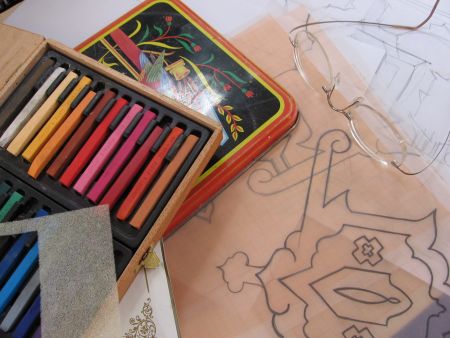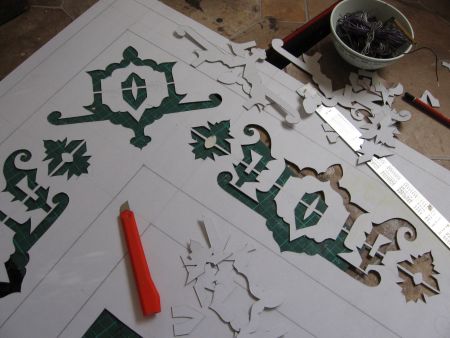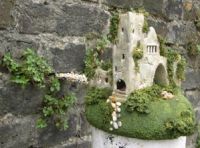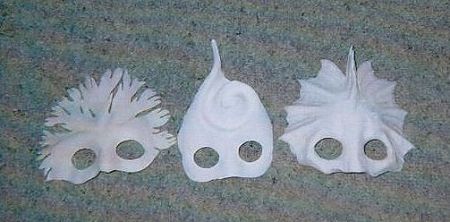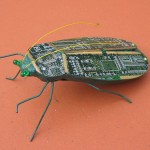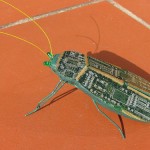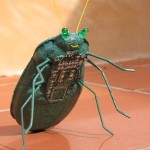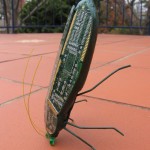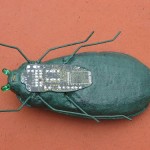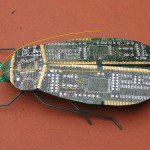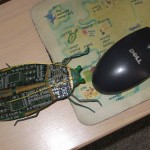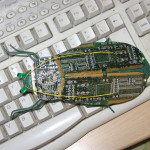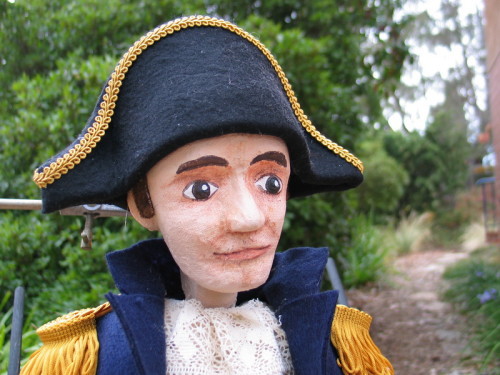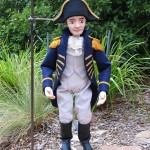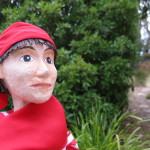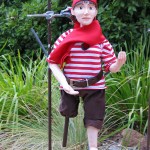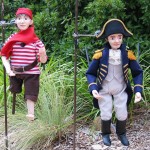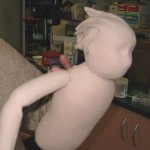Happened across Duct Tape Rachel, a bold photo of the process of making a self-form-fitting duct tape dressmaker’s dummy. It links to an article called Clone yourself a Fitting Assistant by , which in turn shows you four ways of making your own dummy:
make
Stencilling Carpet
My husband’s grandfather had a wide notion of what might be fixed with paint, and it got more extensive as he got older, until he was happily fixing stains in upholstery and carpets with dabs of paint. I’ve been thinking about him today, because I have been spraypainting a border pattern onto a large piece of carpet which is to be used in a play. The design was cut as a stencil:
Moss graffiti and secret worlds
We have been deep in drought for some years, but in just the last few weeks we have had enough rain to encourage small patches of green to peep through, and suddenly there are beautiful verdant mounds of moss appearing in nooks and cracks in the pavement, and around trees in the gardens. I’m beginning to think I might be able to experiment with this recipe from Stories in Space for getting moss to grow in specific areas:
Recipe:
(serves to create several small pieces or 1 large piece of graffiti)
1 can beer,
1/2 teaspoon sugar
several clumps garden moss
Plastic container with lid, blender, paintbrush
‘To begin the recipe, first of all gather together several clumps of moss (moss can usually be found in
moist, shady places) and crumble them into a blender. Then add the beer and sugar and blend just long enough to create a smooth, creamy consistency. Now pour the mixture into a plastic container.
Find a suitable damp and shady wall on to which you can apply your moss milkshake. Paint your chosen design onto the wall (either free-hand or using a stencil). If possible try to return to the area over thefollowing weeks to ensure that the mixture is kept moist. Soon the bits of blended moss should begin to re-couperate into a whole rooted plant – maintaining your chosen design before eventually colonising
the whole area.’
I love the other images and ideas at Stories in Space, in particular Myrmidon Castle (pictured above), and Hideaway.
Ronnie Burkett’s Paper Mache Recipes and other things
Having seen Ronnie Burkett‘s amazing Tinka’s New Dress in its last season at the Melbourne Festival in 2002, and heard him speak so inspiringly at the Puppetry Summit there at the same time, I was interested to see Burkett’s article on paper mache (via Puppetry News and Views).
The article talks about recipes for making one’s own paper mache pulp, and the various situations they are useful for, but Burkett also says that much of the time he now uses a commercial papier mache pulp called Celluclay. I thought it would be ideal for a court jester’s marrotte that I was making, but its hard to come by here, so I tried Mix-It, which is made in Victoria. When I tried an instant paper pulp before many years ago, it was quite lumpy, but this mix turned out to be nice and smooth to work, and dried really hard and white.



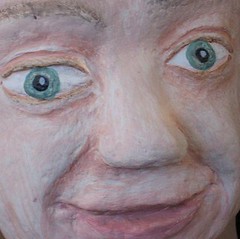
Dave Riley’s Mask Studio tutorials
Dave Riley is a mask-maker, puppeteer and playwright based in Brisbane. His Mask Studio tutorials have been of great help to me a number of times – thanks Dave! There are two mask tutorials:
- Easy mask making using cheap plastic originals (creating a serviceable neutral mask from a cheap plastic model, and then making it into a character mask by adding styrofoam and compressing it to shape).
- Mask making methods using commercial felt.
The felt method is really interesting. It involves soaking the felt in white glue and then moulding it to shape rather like working leather. There are then different finishes to experiment with, including paint, and leather gloss and polish. The result is a very light strong mask.
A few years ago when I first tried it and made a series of animal masks, I built on a paper mache base because I wasn’t sure it would be strong enough otherwise, but recently in making some smaller masks for Hidden Corners’ ‘See Beneath’, I was more confident in using the felt by itself, with a muslin/white glue backing to make the inside comfortable and strong.
The seaweed fronds had a little extra strengthening, just because the shape was not intrinsically strong like the shell. The fishy mask was done a little differently, without felt because I wanted finer detail. It is carved quite thinly out of styrofoam, and has several layers of muslin and white glue to give it strength.
These have a water-based polymer gloss varnish added to the paint, which kind of plasticizes them.
Month of Softies: June bug
You know you are either going loopy, or your new creation has charm, or possibly both, when you find yourself taking it from room to room with you around the house, or with you in the car while driving errands. Especially when its a computer bug. And we won’t mention talking to it.
There are a few other images below. This bug was made for loobylu’s June Month of Softies. My thanks once again, Claire.
Two new recycled creatures
After making a couple of recycled creatures a few months ago, I’ve become a bit obsessed with the idea, and have been haunting the local op shops and trash and treasure markets, looking for suitably interesting bags and belts. I’ve now got far more than I have had time to make up! One side effect of this obsession is eyeing-off bags that people are carrying in shops and on the street.
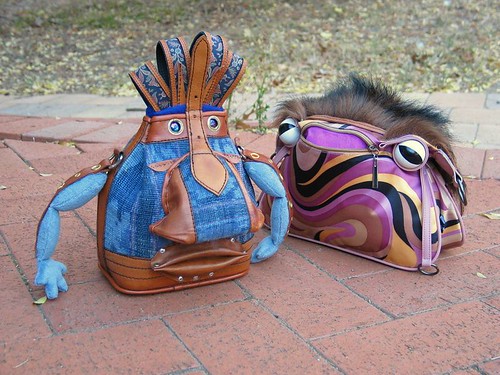
Hidden Corners Theatre: See Beneath
The bunraku-style puppets I was working on are for production called ‘See Beneath’, being presented by Hidden Corners Theatre, Canberra’s award-winning theatre company of young carers. This is how the puppets turned out:
‘See Beneath’ is a play by and about young people dealing with disability in their families, directed by Robin Davidson and barb barnett, with the assistance of Max Barker. Its written by Rebecca Meston and the cast of Hidden Corners, and plays in Melbourne and Canberra during July. Here are season details:Melbourne: Theatreworks, 14 Acland St, St. Kilda.
13 – 16 July, Wed – Sat @ 7.30pm; Sat matinee @ 2pmCanberra: The Street Theatre Studio, Childers St, Civic
21 – 23 July, Thurs – Sat @ 7.30pm; Sat matinee @ 2pm
Foam construction puppet tutorial at Bear Town
I’ve been enjoying PuppetVision Blog for a while now. Based in Toronto, Canada, it casts its net much wider, and looks at video and film puppetry.
PuppetVision’s blogger, Andrew, is also creating Bear Town, a web-based puppetry project. Part of the ‘behind the scenes’ information there is a step-by-step series of articles documenting the making of Tumbles B.Bear. There’s a useful tutorial about a soft foam puppet construction method nicknamed ‘the wedge method’, (free pattern) where a series of wedges is used to a make hollow ball of varying shape, as well as information about how Tumbles’ arms, hands and mouth are made.
Updated 2015: some links broken, some renewed
